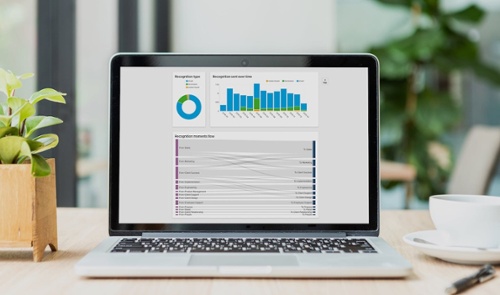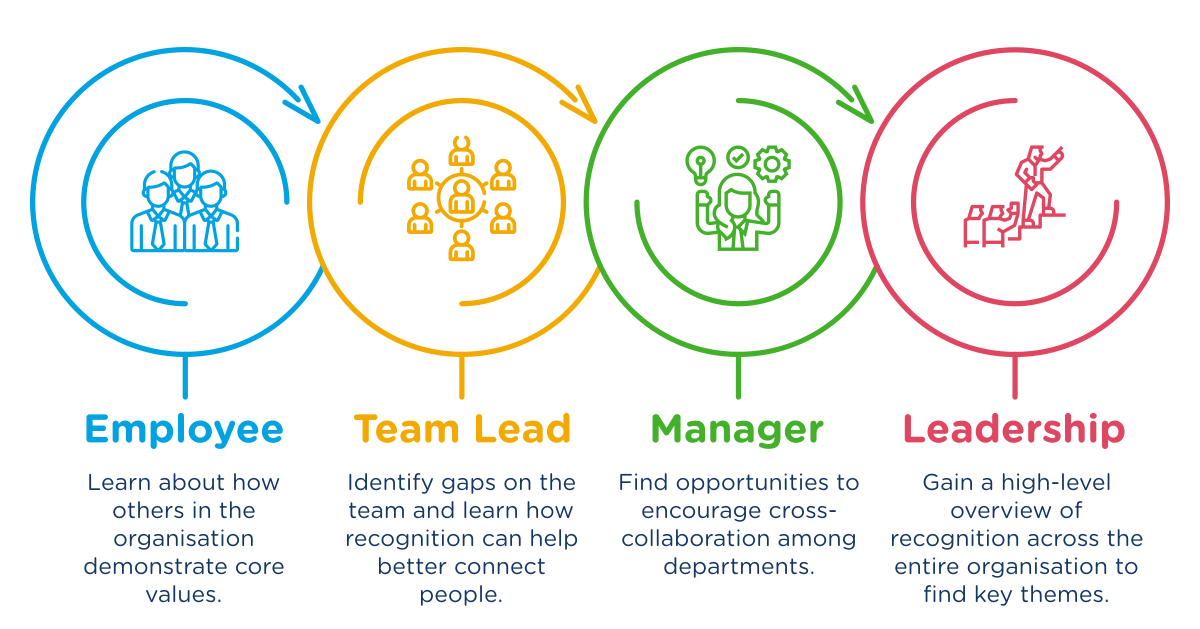6 min read
“Creating a culture of appreciation” is a phrase that’s often used in the workplace. Not only do we all want to show up to work each day and feel like the work we’re doing is making a difference, we want to be appreciated for our efforts by our peers, managers and leaders. But it doesn’t stop there.
Once you create a culture of appreciation, the real work is just beginning – it’s time to measure and look at the data to truly see your culture in action.
Measuring your culture and looking for ways to improve isn’t one team or department’s sole job – it’s the collective effort of everyone at the organisation. And when your people have access to data and key insights at their fingertips, they can not only work towards creating a culture of appreciation, but can see the real impact it has on your organisation to make informed decisions about the business.
Let’s walk through why employee recognition matters to everyone in the workplace and how you can transform company culture by measuring and tracking employee appreciation.

Use employee engagement analytics and reporting to see your culture of appreciation in action
Everyone can benefit from more knowledge. Our constant desire for more information and learning is what makes us human and it applies to all areas of our lives – especially at work. No matter which department or location you work in, what level of employee you are or how you feel about numbers – owning employee engagement is a team effort.
With an employee engagement platform, your people will have on-demand access to the tools they need to stay connected and informed. As part of the solution, everyone has analytics dashboards that put clear and easy-to-understand data into the hands of your people in real-time with the SmartInsights Analytics Engine.
It’s important that all employees have access to the data so they can be informed and play a role in improving employee engagement and appreciation.

1. Employee
When your people are involved, appreciated and feel like a part of the bigger picture, they’re more likely to advocate for your organisation and become champions (or what we like to call “ambassadors” in your Employee Engagement Quadrant!). Your employees are the end-users of your employee engagement platform, which means their feedback and participation is unmatched.
How they’ll benefit from analytics:
- Learning about how others in the organisation demonstrate core values
- Understanding how they can contribute to the culture of continuous appreciation by recognising a certain person, team or by a certain value
2. Team lead
Your team leads are invaluable to your engagement strategy and culture transformation initiatives because they have a direct connection to your employees. Team leads provide hands-on guidance and feedback from front-line employees that help inform other leaders and departments about how things are going or what areas can be improved. Think of team leads as your “on-the-ground” ambassadors that can elevate members of their team to the next level of the Employee Engagement Quadrant.
How they’ll benefit from analytics:
- Identifying gaps on their own team and how recognition can help better connect people
- Determining where their team sits within the wider business by looking at cross-departmental recognition
3. Manager
Unsurprisingly, managers need to be aligned with your organisation’s purpose, mission and values. You need your managers to be bought in to what you are doing and you need them to run initiatives in their local teams, to feedback, to help share and shape what you are doing. They are key to driving cultural change and uniting your workforce.
How they’ll benefit from analytics:
- Identifying individuals on their team who go above and beyond to help other departments
- Identify employees that may be “at-risk” for disengagement based on the level of recognition they’re receiving (and from whom)
- Find opportunities for members of their teams to receive or give recognition from other locations or teams to encourage cross-collaboration among departments
4. Leadership
Your senior leaders (think, your CEO, CFO or COO) need to be the drivers of your engagement initiatives. We know that leadership participation is key to overcoming engagement challenges and these are the people who can be your secret weapon, as well as drive your culture initiatives forward. How? Make sure your leaders are looking at the data and understand how it aligns to their (and the company’s) objectives.
How they’ll benefit from analytics:
- Gaining a high-level overview of recognition across the entire organisation to find key themes, insights or areas of improvement (for instance, are only pockets of managers recognising? More training may be needed to reinforce the culture of continuous appreciation.)
- Identifying top performers in the organisation to determine the potential leaders to drive new initiatives
- Spot “at-risk” teams that may impact retention or employee satisfaction
Ensure ongoing success with data-driven questions
As we mentioned before, people respond to things in different ways. That’s why it’s important to look at data in different ways so that it tells a story in a way that makes sense to you, so that you have actionable ways to improve your culture.
Above all, the most important thing you can do when measuring a culture of appreciation is to never stop asking questions and being curious.
Of course, your insights and takeaways will be unique to your own organisation and its culture, but we’ll highlight some questions to get you started on using 360 recognition to gain business insight.
| 1. | Is there a particular team (or location) that isn’t getting recognised for their hard work? |
| 2. | Are there certain values that people are recognising others (or being recognised) for among others? |
| 3. | What’s the breakdown between manager-led and peer-to-peer recognition at your organisation? |
| 4. | Is there higher turnover in a certain department or location? |
| 5. | Were there higher periods of recognition throughout the year? Do those relate to company-wide initiatives? |
It may be overwhelming to know where to start, which is why finding a partner who can help unravel the data for you is key to your engagement initiatives' success.

When recognition and personality come together
Remember, not all personalities and recognition are treated equally. Have you ever heard of the Insights Assessment? If not, here’s a quick summary: The Insights Assessment helps teams discover how each personality profile helps the business and it all has to do with which colour (or colours) employees lead with. There are four colours (Red, blue, yellow and green) and you are likely to have a combination of all of them.
Here’s more on what each of these colours mean and how it impacts decision-making, employee relationships and ongoing success:
| Fiery Red | People with a preference for dominant "Fiery Red" energy are extroverted and have high energy. They are action-oriented and always in motion. They will approach others in a direct, authoritative manner, radiating a desire for power and control. |
| Sunshine Yellow | People with a preference for dominant "Sunshine Yellow" energy are strongly extroverted, radiant, and friendly. They are usually positive and concerned with good human relations. They will approach others in a persuasive, democratic manner, radiating a desire for sociability. |
| Earth Green | People with a preference for dominant "Earth Green" energy are introverted with a strong focus on values and in-depth relationships. They want others to be able to rely on them. They prefer democratic relations that value the individual and are personal in style, radiating a desire for understanding. |
| Cool Blue | People with a preference for dominant "Cool Blue" energy are introverted and have a desire to know and understand the world around them. They prefer written communication in order to maintain clarity and precision, radiating a desire for analysis. |
Understanding someone else’s preferences and tendencies helps you be a better teammate and know how to recognise them. And while the Insights colours are great for recognising, they’re also essential for understanding how the recognition moments affect your team or the business overall.
Employee recognition is key to improving employee engagement. And with engagement analytics and reporting, you’ll never miss a beat. The dashboards give insight into key indicators, such as overall employee engagement, recognition activity and social responses that can impact important business metrics, such as employee turnover or customer satisfaction.
Ready to use real-time analytics to improve your business results? Chat with one of our Engagement Specialists today.
%20(1).jpeg) Alexandra Powell
Alexandra Powell




